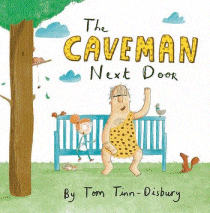
The Caveman Next Door
The Caveman Next Door
Tom Tinn-Disbury
New Frontier, 2019
32pp., hbk., RRP $A24.99
9781925594850
Penny’s street and home were just like any others until a caveman moved into an empty lot next door. A caveman who cooked his meals outside, didn’t have a TV, didn’t wear socks and whose furniture (what there was of it) was made of sticks and stones. And he didn’t speak English – all he could do was grunt.
One day after school, Penny decided to show him around the neighbourhood – the library, the bus, the park, a restaurant… But wherever they went, and no matter how hard he tried, Ogg didn’t know what to do or how to act and they were shown the door of every place. Until Penny took him to her school…
It’s hard enough fitting into a new neighbourhood when you speak the language and have mastered the social niceties, but to do so without either of these like Ogg, must be overwhelming and daunting. And yet, with our multicultural and global perspective that welcomes people from all over the world, this must be a common experience for many. While the children are able to go to school, make friends, learn the language and the expectations, parents, particularly mums, are left at home isolated, mixing only with others who share their lifestyle and so a vicious cycle of exclusion and racism begins. While Ogg’s attempts to do the right thing are funny, there is an underlying pathos at his awkwardness and also a sadness at the actions of those who object to his actions. Only at school does he find compassion.
Using a caveman analogy to bring awareness to the issues of being different is clever because not only does it highlight just how hard it can be, no one can criticise the author for being insensitive towards one group or another. It certainly opens up the opportunities for discussions about how we respond to newcomers and identifying those things peculiar to us that they might have difficulty adjusting to as well as putting the students in Ogg’s shoes. With space travel on the horizon, what if they went to Mars to live and found there were indeed Martians…?
While the theme of being different, fitting in and accepting others is common in children’s picture book, even though it might be expressed in a unique way each time, the more often we expose our students to these sorts of stories and talk about them, provoke their thinking and even develop strategies to embrace all, then the better and stronger the communities we build will be. Strong, united communities are the key to a peaceful, harmonious future if we are to move beyond the current, nationalistic “our best interests” philosophy and look at what is good for humanity as a whole.